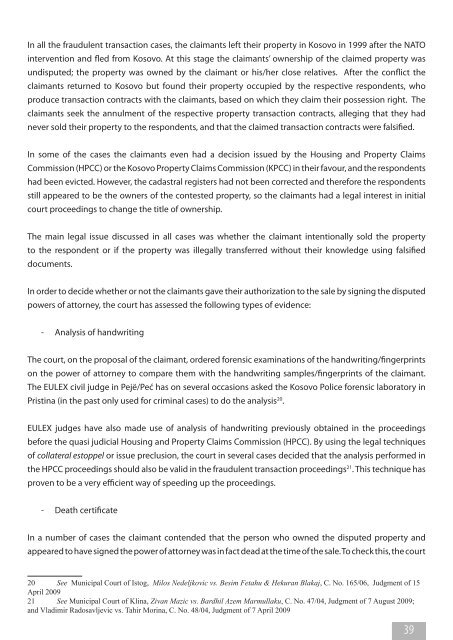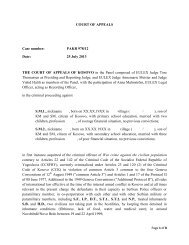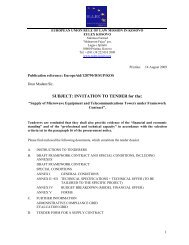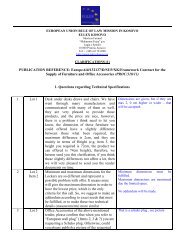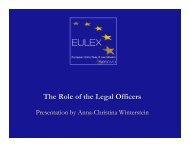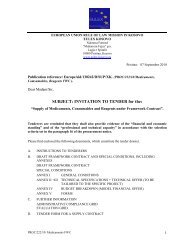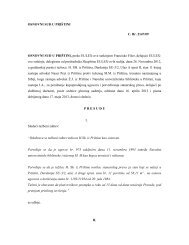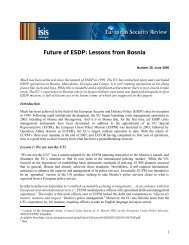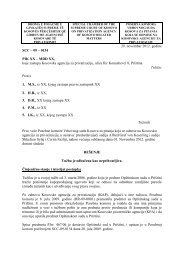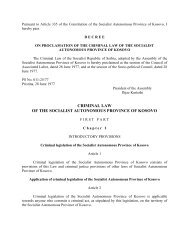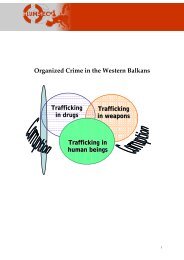English - Eulex
English - Eulex
English - Eulex
You also want an ePaper? Increase the reach of your titles
YUMPU automatically turns print PDFs into web optimized ePapers that Google loves.
In all the fraudulent transaction cases, the claimants left their property in Kosovo in 1999 after the NATO<br />
intervention and fled from Kosovo. At this stage the claimants’ ownership of the claimed property was<br />
undisputed; the property was owned by the claimant or his/her close relatives. After the conflict the<br />
claimants returned to Kosovo but found their property occupied by the respective respondents, who<br />
produce transaction contracts with the claimants, based on which they claim their possession right. The<br />
claimants seek the annulment of the respective property transaction contracts, alleging that they had<br />
never sold their property to the respondents, and that the claimed transaction contracts were falsified.<br />
In some of the cases the claimants even had a decision issued by the Housing and Property Claims<br />
Commission (HPCC) or the Kosovo Property Claims Commission (KPCC) in their favour, and the respondents<br />
had been evicted. However, the cadastral registers had not been corrected and therefore the respondents<br />
still appeared to be the owners of the contested property, so the claimants had a legal interest in initial<br />
court proceedings to change the title of ownership.<br />
The main legal issue discussed in all cases was whether the claimant intentionally sold the property<br />
to the respondent or if the property was illegally transferred without their knowledge using falsified<br />
documents.<br />
In order to decide whether or not the claimants gave their authorization to the sale by signing the disputed<br />
powers of attorney, the court has assessed the following types of evidence:<br />
-<br />
Analysis of handwriting<br />
The court, on the proposal of the claimant, ordered forensic examinations of the handwriting/fingerprints<br />
on the power of attorney to compare them with the handwriting samples/fingerprints of the claimant.<br />
The EULEX civil judge in Pejë/Peć has on several occasions asked the Kosovo Police forensic laboratory in<br />
Pristina (in the past only used for criminal cases) to do the analysis 20 .<br />
EULEX judges have also made use of analysis of handwriting previously obtained in the proceedings<br />
before the quasi judicial Housing and Property Claims Commission (HPCC). By using the legal techniques<br />
of collateral estoppel or issue preclusion, the court in several cases decided that the analysis performed in<br />
the HPCC proceedings should also be valid in the fraudulent transaction proceedings 21 . This technique has<br />
proven to be a very efficient way of speeding up the proceedings.<br />
-<br />
Death certificate<br />
In a number of cases the claimant contended that the person who owned the disputed property and<br />
appeared to have signed the power of attorney was in fact dead at the time of the sale. To check this, the court<br />
20 See Municipal Court of Istog, Milos Nedeljkovic vs. Besim Fetahu & Hekuran Blakaj, C. No. 165/06, Judgment of 15<br />
April 2009<br />
21 See Municipal Court of Klina, Zivan Mazic vs. Bardhil Azem Marmullaku, C. No. 47/04, Judgment of 7 August 2009;<br />
and Vladimir Radosavljevic vs. Tahir Morina, C. No. 48/04, Judgment of 7 April 2009<br />
39


